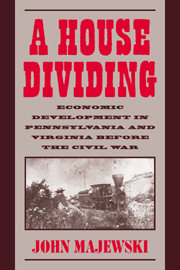Book contents
- Frontmatter
- Contents
- List of Tables
- List of Abbreviations
- Acknowledgments
- Maps
- Introduction: Regional Development in Comparative Perspective
- 1 Developmental Corporations in a Slave-Labor Society
- 2 Developmental Corporations in a Free-Labor Society
- 3 Railroads and Local Development
- 4 The Local Politics of Market Development
- 5 Urban Capital and the Superiority of Pennsylvania's Transportation Network
- 6 Why Antebellum Virginians Never Developed a Big City: Comparative Urban Development in Philadelphia and Eastern Virginia
- Epilogue: Railroad Networks and the Civil War
- Appendix on Sources and Methods
- Bibliography
- Index
Epilogue: Railroad Networks and the Civil War
Published online by Cambridge University Press: 07 September 2010
- Frontmatter
- Contents
- List of Tables
- List of Abbreviations
- Acknowledgments
- Maps
- Introduction: Regional Development in Comparative Perspective
- 1 Developmental Corporations in a Slave-Labor Society
- 2 Developmental Corporations in a Free-Labor Society
- 3 Railroads and Local Development
- 4 The Local Politics of Market Development
- 5 Urban Capital and the Superiority of Pennsylvania's Transportation Network
- 6 Why Antebellum Virginians Never Developed a Big City: Comparative Urban Development in Philadelphia and Eastern Virginia
- Epilogue: Railroad Networks and the Civil War
- Appendix on Sources and Methods
- Bibliography
- Index
Summary
Virginia's railroads on the eve of the Civil War – a collection of local lines that failed to reach the Midwest – typified the southern network as a whole. While the South and the North were about equal in per capita mileage, the northern network almost tripled the South's on a square-mile basis. Moreover, southern railroads generally had fewer stations, fewer employees, and less rolling stock than their northern counterparts. Southern inferiority largely stemmed from the region's lack of integrated trunk lines. Historian Tony A. Freyer, for example, has compared the “centralized private managerial power” of northern railroads with the South's failure to “consolidate the region's roads into unified systems.” Even Robert William Fogel, who depicts a growing and prosperous southern economy, contrasts “the great railroad trunk lines connecting the cities of the Midwest and the East” with the conspicuous absence of “railroad links between the Midwest and the South.”
Southerners would pay a high price for their lack of trunk lines. Economically, manufacturers along the South Atlantic coast would have only limited access to midwestern markets. Economic isolation, in turn, had profound cultural significance. Historian Ronald J. Zboray argues that as northern railroad systems grew more integrated, book publishing became concentrated in a few northern cities such as New York and Boston. Literature hostile to slavery – including the runaway bestseller Uncle Tom's Cabin – emanated from these commercial centers to an increasingly large number of northern towns, hamlets, and villages.
- Type
- Chapter
- Information
- A House DividingEconomic Development in Pennsylvania and Virginia Before the Civil War, pp. 168 - 172Publisher: Cambridge University PressPrint publication year: 2000



